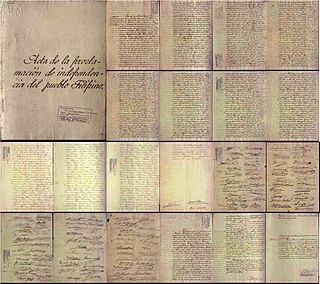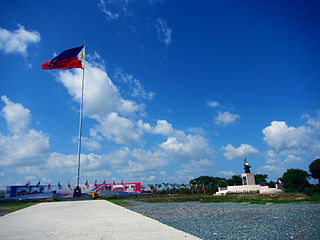
Emilio Aguinaldo y Famy was a Filipino revolutionary, statesman, and military leader who is the youngest president of the Philippines (1899–1901) and became the first president of the Philippines and of an Asian constitutional republic. He led the Philippine forces first against Spain in the Philippine Revolution (1896–1898), then in the Spanish–American War (1898), and finally against the United States during the Philippine–American War (1899–1901).

The Philippine Revolution was a war of independence waged by the revolutionary organization Katipunan against the Spanish Empire from 1896 to 1898. It was the culmination of the 333-year colonial rule of Spain to the archipelago. The Philippines were among the last colonies of the Spanish Empire, which saw a massive decline particularly in the 1890s. Cuba rebelled in 1895, and the empire soon fought against the United States in a war that they lost. In June 1898, Philippine revolutionaries declared itself a republic. However, this was not recognized by Spain, which sold the islands to the United States in the Treaty of Paris.

Pedro Alejandro Paterno y de Vera Ignacio was a Filipino politician infamous for being a turncoat. He was also a poet and a novelist.

Miguel Malvar y Carpio was a Filipino general who served during the Philippine Revolution and, subsequently, during the Philippine–American War. He assumed command of the Philippine revolutionary forces during the latter, following the capture of resistance leader Emilio Aguinaldo by the Americans in 1901. According to some, he could have been listed as one of the presidents of the Philippines; however, as of 2023, is not recognized as such by the Philippine government.

The Philippine Declaration of Independence was proclaimed by Filipino revolutionary forces general Emilio Aguinaldo on June 12, 1898, in Cavite el Viejo, Philippines. It asserted the sovereignty and independence of the Philippine islands from the 300 years of colonial rule from Spain.
On November 1, 1897, the Republic of Biak-na-Bato was established in the cave of Biak-na-Bato, San Miguel de Mayumo, Bulacan. A special election was called for the new Supreme Council to oversee the newly established government on November 2, 1897 in the Philippines.

Doña Marcela Mariño de Agoncillo was a Filipina who was the principal seamstress of the first and official flag of the Philippines, gaining her the title of "The Mother of the Philippine Flag."

The Republic of Biak-na-Bato was the second revolutionary republican government led by Emilio Aguinaldo during the Philippine Revolution that referred to itself as the Republic of the Philippines and was seated in what is now Biak-na-Bato National Park. The current designation was adopted by historians to avoid confusion with the name of the current Philippine government, which also refers to itself as the Republic of the Philippines, and with other past Philippine governments using the same designation.
The sovereignty of the Philippines refers to the status of the Philippines as an independent nation. This article covers sovereignty transitions relating to the Philippines, with particular emphasis on the passing of sovereignty from Spain to the United States in the Treaty of Paris (1898), signed on December 10, 1898, to end the Spanish–American War. US President William McKinley asserted the United States' sovereignty over the Philippines on December 21, 1898, through his Benevolent Assimilation Proclamation.

The Hong Kong Junta was an organization formed as a revolutionary government in exile by Filipino revolutionaries after the signing of the Pact of Biak-na-Bato on December 15, 1897. It was headed by Emilio Aguinaldo and included high-level figures in the Philippine revolution against Spanish rule who accompanied Aguinaldo into exile in the Crown Colony of Hong Kong from the Philippines.
This is a list of notable events that happened in the Philippines in the year 1897.

José Cándido Alejandrino y Magdangal was a Philippine Republican Army general during the Philippine Revolution and the Philippine–American War.

Pablo Ocampo Tecson was an officer in the Revolutionary Army serving under Gen. Gregorio del Pilar and a representative to the Malolos Congress. He was elected the Governor General of Bulacan immediately following the Philippine–American War. Tecson later served as Insular Secretary of the Philippine Bureau of Agriculture.

The Battle of Alapan was fought on May 28, 1898, and was the first military victory of the Filipino Revolutionaries led by Emilio Aguinaldo after his return to the Philippines from Hong Kong. After the American naval victory in the Battle of Manila Bay, Aguinaldo returned from exile in Hong Kong, reconstituted the Philippine Revolutionary Army, and fought against the Spanish troops in a garrison in Alapan, Imus, Cavite. The battle lasted for five hours, from 10:00 A.M. to 3:00 P.M.

General Mamerto Alejandrino Natividad was a haciendero and a Filipino military leader who led numerous successful battles during the Philippine Revolution against the Spaniards. He is credited with establishing army headquarters at Biak Na Bato, which today is a national park because of its historical significance. Together with Jose Clemente Zulueta, he wrote the proclamation entitled “To The Brave Sons of the Philippines”, which called for the expulsion of the friars from the Philippines. He was a signatory to the Biak Na Bato convention, but a steadfast dissenter to the Treaty of Biak Na Bato, which asked for peace and reforms. He preferred independence.
The Battle of Tayabas was a 2-month campaign of the Philippine Revolution that saw intense guerrilla warfare and bloodshed for the province. The battle occurred shortly after Aguinaldo's return from Hong Kong in May of the same year. Tayabas was just one of the many triumphs for the revolutionaries in that year, leading up to Philippine independence.

The Central Executive Committee in the Philippines was an insurgent revolutionary government temporarily established by Francisco Macabulos on April 17, 1898, shortly after the December 14, 1897, signing of the Pact of Biak-na-Bato. That pact established a truce between Spanish colonial authorities in the Philippines and the revolutionary Republic of Biak-na-Bato calling for the exile of Emilio Aguinaldo and other senior revolutionaries. The exiled revolutionaries formed the Hong Kong Junta, and the Central Executive Committee was intended to remain in existence in the Philippines "until a general government of the Republic in these islands shall again be established, with a constitution which provided for a President, Vice President, Secretary of War and Secretary of the Treasury.." The committee was dissolved shortly after Aguinaldo's May 19, 1898, return to the Philippines.

Salvador Estrella was a Filipino general who fought in the Philippine Revolution and the Philippine–American War. For his courage in battle, he earned the moniker "red blooded."
A revolutionary government or provisional government has been declared a number of times in the Philippines, by various insurgent groups.

The Dictatorial Government of the Philippines was an insurgent government in the Spanish East Indies inaugurated during the Spanish–American War by Emilio Aguinaldo in a public address on May 24, 1898, on his return to the Philippines from exile in Hong Kong, and formally established on June 18. The government was officially a dictatorship with Aguinaldo formally holding the title of "Dictator". The government was succeeded by a revolutionary government which was established by Aguinaldo on June 23.

















